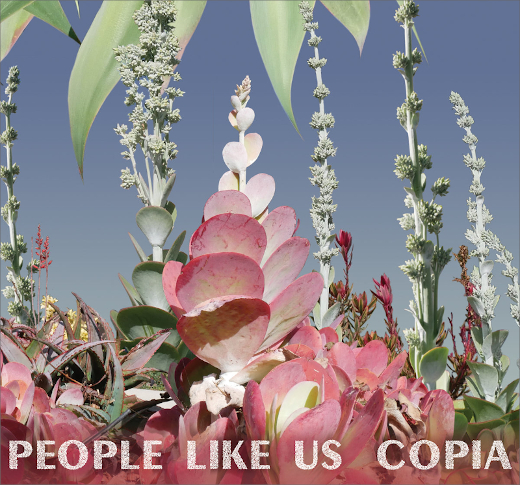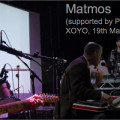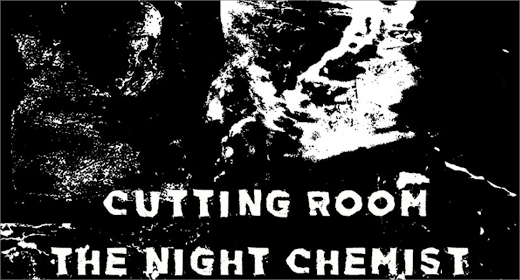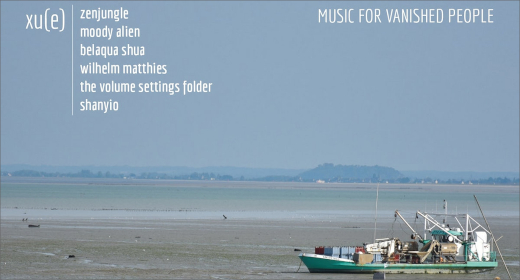In a way this album can be thought of as a collective mirror reflecting the sound prerogatives and choices of People Like Us and the many guest musicians involved as they wander through the library. From this fact people often infer that the library is infinite, because it sounds like they have used an infinite number of pieces to create this kaleidoscopic collection of musical associations.

Planetary-scale collage
Listening to a People Like Us album is akin to combing through the ruins of the Library of Babel. Odd bits and pieces collide together into strange and giddy mosaics. What is a Library of Babel? A Library of Babel is a place where we can do what we want to do. It is a place where you can go and create something new out of the old. It is a place where, when you look through the bibliography, one citation leads on a trail to another and another. A library is a place where many things can be sampled for free. Once all the material has been checked out, it can be taken over to the mixing desk to be rearranged inside the studio of the imagination, taken apart and reassembled, recombined into new copious compositions. From the vast cornucopia of all that there is to copy Vicki Bennett of People Like Us has gone into the Library of Babel and come back out unscathed. From this rich abundance of material she has further enriched our shared musical with her album COPIA.
The album is a many layered work, and one way to listen to it is as a hymn to collage. Making collage music takes just as much experience and craftsmanship as learning to play a traditional instrument. Part of the issue in developing skill as a collagist is building up a large collection of material to make music from, and then forming the mental and musical links between all the different elements and possibilities. This is the art of combination and Bennett has long since passed the point of practice and into the field of mastery, and this is a masterwork.
This album of babel music (which others call “Copia”) is composed of an indefinite, perhaps infinite number of musical galleries. In the center of each song is a particular sample that sometimes functions as a keystone, but leads out into an infinite array of even more samples. In a way this album can be thought of as a collective mirror reflecting the sound prerogatives and choices of People Like Us and the many guest musicians involved as they wander through the library. From this fact people often infer that the library is infinite, because it sounds like they have used an infinite number of pieces to create this kaleidoscopic collection of musical associations.
We are in a part of the universe where art makes and breaks the rules ::
In the first track, “Glass Onion” we hear the “Theme from a Summer Place,” which will be familiar to fans of Vicki’s radio show on WFMU, Do or DIY. She has used that, especially on summer programs, for quite a number of years, and hearing it brings back all the joy of those radio shows full of “pop and avant-garde side by side, sometimes on top of one another.” After this brief tidbit, and a bit of joyful whistling, Bennet gives us a key for navigating the overflowing hallways of the album with a recitation, where she says “In this tesseract of tales / every shelf a new dimension / where the laws of physics / bow to literary invention / … / our map to navigate / the stars guiding seekers / through time and space.” This is how we know we are in a part of the universe where art makes and breaks the rules. The voice of Ergo Phizmiz is present here as well, and they start singing an interdimensional duet about copious realities, asking the question “what is there when you pull the curtain back?” This is what it is like listening to this bibliotech about a tesseract. The rest of the album is reconstructed from the shards of the glass onion after it has been shattered into a million tiny samples.
Every wanderer who goes through the library of babel could make their own construction, their own mix from biblical passages pasted on top of cookbooks. It’s just a matter of when you wish upon a star. “You Wish” is on the album in two versions. The first is the “Dark World” mix. Here we enter a surrealist dreamscape. It reminds me of that scene in the movie The Labyrinth when Sarah eats the enchanted peach and finds herself in a murky masquerade ball filled with phantasmagoria. Here the familiar is transformed into something much less so, while still triggering the memories of things we know. The melody for “when you wish upon a star” as played on kids set of chimes or a glockenspiel, acts as a kind of section marker between different parts of the song. As the song drifts into its last parts bits of dusty acoustic guitar wash through the prismatic haze before a dizzy harpsichord and treated electronics fizz towards the end. This is the kind of music that gives Disney executives headaches and bad dreams. For minds like mine, it’s pure fun.
The next track shows off the People Like Us penchant for pop music. It’s as if we have put on a juke box in a 1950s diner or malt shop and more songs about wishes and rainbows cascade out of the speakers where they split into different colors. In this defamiliarized territory little traces and squiggles on the map remind us of places we have been before, but we are not there. We are somewhere else. These are the new happy days. The song “Happy Jam” is just that and it is always and always forever. Another great thing about collage is how it resurrects the past and retrofits it for future use.
“Hymn to Collage” starts off with cut-up instructions on how to make cut-up writings. It’s the DIY ethic that Bennett practices so well here given back to her listeners so they can go make their own collages. Then the People Like Us chorus comes to sing the same lyrics that had been made of cut-ups themselves to pulsing electronica as I learn to “copy conscientiously.” Pounding drum beats and what sounds like the booper used by Negativland then come into the song before a brief abstract interlude. The song ends with the provocative words about what a real work of art is. Here she confronts the critics of this style of music and art head on. Fair to say this is art, and anyone who has made so many audio edits before, or glued so many fragments of visual material together, knows just how much work it really is.
Combining musical genius and comedic genius ::
What follows is the piece “Nature.” On this track Skeeter Davis is present talking about the end of the world, or perhaps the end of nature. People Like Us aren’t afraid of darker moments, but there is always humor present. Combining musical genius and comedic genius isn’t easy, but People Like Us manage it every time in a way that I can only compare to Weird Al Yankovic and Frank Zappa.
“I Only Have Eyes for PLU” keeps the love flowing in the center of the album while the track “LSD Cha Cha” ends with the familiar strains of Tom Clay and what the world needs now. Maybe more LSD, but certainly more love.
“Buzzy B” is a kind of Zappa-esque leftfield jazz number and features an ensemble cast. This is also a very collaborative album. It could be said that even when working solo Vicki is collaborating, in the way she uses the works of others as raw materials. Here the other collaborators are old friends she has been joined with on previous outings and radio phonic adventures. Besides Ergo Phizmiz, the star cast who appear on various tracks include Irene Moon, Matmos, Gwilly Edmondez, Hearty White, Lottie Bowater, Matt Warwick, and Jon Leidecker (Wobbly / Negativland) among others. The title for the track “Lester Plays Trumpet, Gwilly and Lottie Sing, Hearty Plays Organ, Douglas Plays Melodica” kind of says it.
“Fate Is Kind” is another track that features the “Theme from a Summer Place” (I think) but here played on organ segueing seamlessly into a complete different song as also played on organ. It could be, that by now my mind and ears may well be playing tricks on me.
“Marais in Mercury” is another great track featuring Ergo Phizmiz on lead vocals, but with Vicki’s sometime accompanying. This recalls other great Ergo Phizmiz pieces, such as “The Seven Hills of Rome” on Welcome Abroad. I like it when they glue their work together.The words are at once mythical and whimsical. It might be surmised from the lyrics that a bit of mercury in the hat may lead one to becoming mad. The song is about the actor and artist Jean Marais, the lover of Jean Cocteau. Here we traverse a wondrous fantasia on Cocteau’s Orpheus films. This track taps into another theme of the album: the underworld, the place you get to when you go down rabbit holes.
“Camera Obscura” turns the subject again to inverted realities and alchemies. It’s a cinematic world, where the camera obscura is inside your head. The universe is itself magic. There are holes in reality you can look through and see everything as it really is – upside down. Or it might be as the John Lennon quote sings, “nothing is real.”
The last song reminds us that magical and musical universe is calling our name. “Music Alone” takes us to our own gentle kind of heaven and proves that electronic sample-based music can be just emotionally evocative and touching as any other.
As ever more aspects of earthly life are rendered sampleable, harvested into clouds, funneled into algorithmic engines — leading to what has been called “planetary-scale collage” — the dreams of musicians like People Like Us about the vast creative and emancipatory possibilities of the cut-up technique continue to endure. The initial trickles of the arcane combinatorial fantasies pioneered by the likes early tape artists have gradually given way to ubiquitous sampling technologies, practices, and ideals which are interwoven into the fabric of our lives — the broader consequences of which are still unfolding around us. The objects of their embryonic faith in collage have become the living a priori of the digital age — providing the conditions for copying everything possible to make use of it for a new art out of the ruins of the Library of Babel.
COPIA is available on Bandcamp.



















![Ndorfik & madebyitself :: Solos EP (People Can Listen) — [concise]](https://igloomag.com/wp/wp-content/uploads/2025/04/ndorfik-madebyitself-solos_feat-75x75.jpg)








